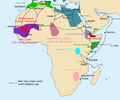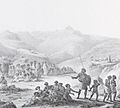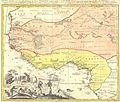African slave trade facts for kids
The African slave trade was where African people were traded as slaves across the world.
The first main route passed through the Sahara.
After the Age of Exploration, African enslaved people became part of the Atlantic slave trade, from which comes the modern, Western type of slavery.
Despite being against the law, slavery continues in all parts of the world, including Africa. In Mauritania slavery was not made illegal until August 2007.
Images for kids
-
A Zanj slave gang in Zanzibar (1889)
-
Malagasy slaves (Andevo) carrying Queen Ranavalona I of Madagascar
-
Nubians waiting to be sold at a slave market in ancient Egypt.
-
Release of Christian slaves by payment of ransom by Catholic monks in Algiers in 1661.
-
Black Zanjs captured in a slave raid being marched to a slave market in the Arab world.
-
A 'servant-slave' woman in Mogadishu (1882–1883)
-
Slaves in Ethiopia, 19th century.
-
A slave market in Khartoum, c. 1876
-
Elderly female slave, c. 1911/15, owned by Njapundunke, mother of the Bamum king Ibrahim Njoya
-
Swahili-Arab slave traders and their captives along the Ruvuma River in Mozambique, 19th century
-
African slaves working in 17th-century Virginia, by an unknown artist, 1670
-
Slave trade along the Senegal River, kingdom of Cayor
-
Photograph of a slave boy in Zanzibar. 'An Arab master's punishment for a slight offence.' c. 1890.
-
Cowrie shells were used as money in the slave trade
See also
 In Spanish: Esclavitud en África para niños
In Spanish: Esclavitud en África para niños

























